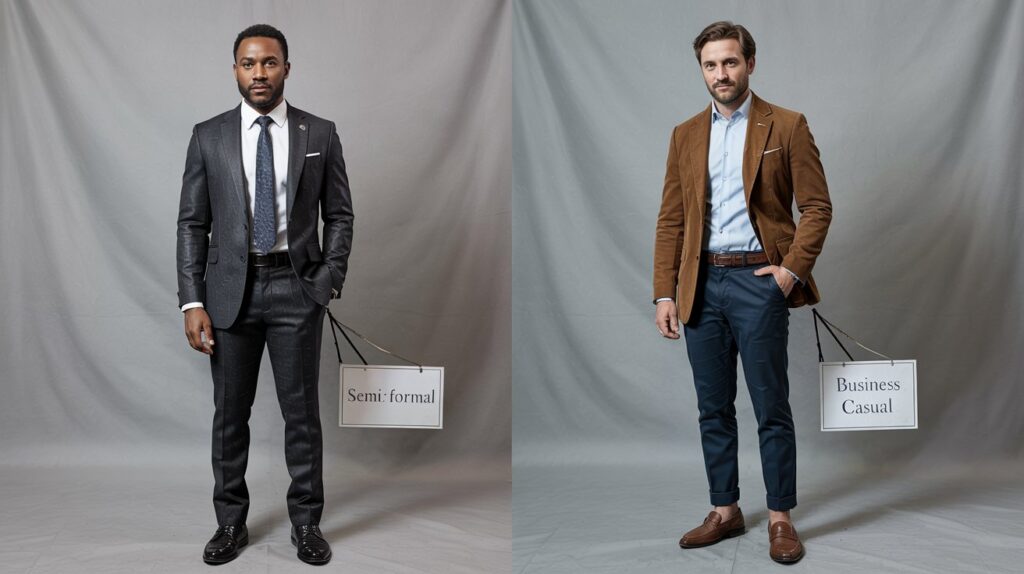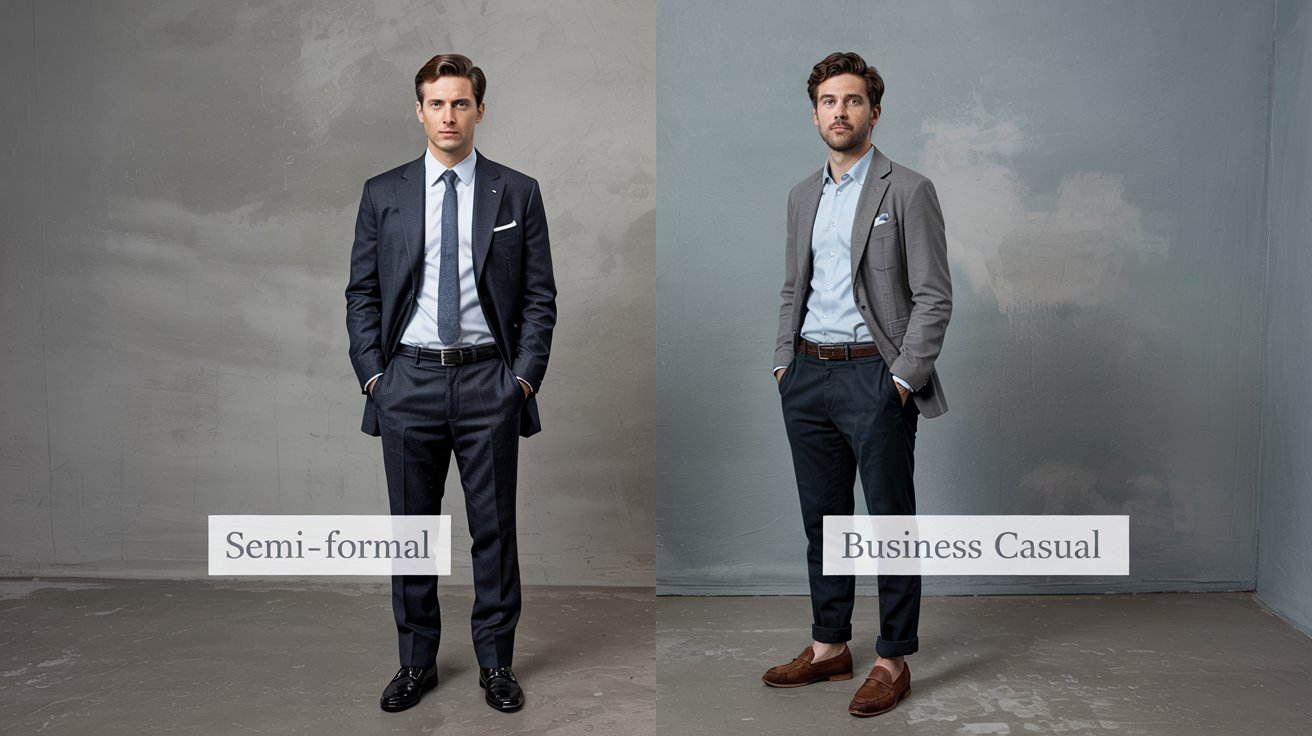Have you ever found yourself staring at an invitation or a meeting notice, utterly confused about what semi-formal or business casual actually means? It’s one of those modern-day dilemmas, isn’t it? In a world where “dress code” seems to be open to interpretation, understanding the nuances between semi-formal and business casual for men can save you from a sartorial misstep.

Understanding Dress Codes: Why Does It Matter?
At its core, the dress code provides a guideline to ensure you dress appropriately for different settings. Decoding these can make all the difference in your social and professional presence. Dressing appropriately isn’t just about fitting in; it’s about feeling confident and comfortable, enabling you to express your true self within the context.
What is Semi-Formal for Men?
The semi-formal dress code traditionally lies somewhere between the formal and informal dress spectrum. It is often associated with events that are elegant yet not overly extravagant. Think of weddings, fundraisers, or dinner parties where you want to look polished but not overly formal.
Key Components of Semi-Formal Attire
- Suits: A suit with a matching jacket and trousers is your go-to here. Opt for subtle colors like navy, charcoal, or black.
- Shirts: A dress shirt in white or light pastel colors works best. Ensure it is well-pressed and clean.
- Ties: Though optional, a tie can elevate your outfit. Patterns should be minimalistic and colors should complement the suit.
- Shoes: Leather dress shoes like Oxfords or Derbies. Ensure they’re well-polished.
- Accessories: A sleek watch, pocket square, and cufflinks can add a touch of class.
Examples of Semi-Formal Situations
You’re likely to encounter a semi-formal dress code at weddings, gala dinners, or sophisticated parties. These occasions might call for a notch up from your usual business wear.
What is Business Casual for Men?
Business casual is less rigid and allows for more personal style yet maintains a professional touch. It is a common dress code in many modern workplaces that wish to promote comfort without sacrificing decorum.
Key Components of Business Casual Attire
- Trousers: Chinos or dress slacks in neutral colors like khaki, grey, or navy.
- Shirts: Button-down shirts in solid colors or subtle patterns. Polo shirts might be acceptable in more relaxed environments.
- Jackets: A blazer is optional but adds a smart touch to the ensemble.
- Shoes: Loafers, brogues, or two-tone shoes provide a polished finish without being too formal.
- Accessories: Minimal and functional – a subtle belt and a watch should suffice.
Examples of Business Casual Situations
Typical settings include casual Fridays at work, networking events, and informal meetings. Wear it when you want to present yourself as professional yet approachable.
Distinguishing Features: A Quick Comparison
Often, seeing elements side-by-side makes their differences clear. Let’s break down these dress codes into a table for a clearer understanding.
| Aspect | Semi-Formal | Business Casual |
|---|---|---|
| Occasion | Weddings, galas, evening parties | Office settings, networking events, casual meetings |
| Suits | Required | Optional |
| Shirts | Dress shirts, preferably in whites or pastels | Button-down or polo shirts |
| Ties | Optional but recommended | Not required |
| Shoes | Dress shoes like Oxfords or Derbies | Loafers, brogues |
| Accessories | Pocket squares, cufflinks | Minimal, like belts and watches |

Outfit Ideas for Semi-Formal Occasions
Getting your semi-formal look right involves balancing style with elegance. Here are some outfit ideas.
Classic Navy Suit and White Shirt
- Suit: Navy blue, two-button suit.
- Shirt: Crisp white dress shirt.
- Tie: A silk tie with a subtle pattern.
- Shoes: Black leather Oxfords.
- Accessories: Silver cufflinks and a matching watch.
Charcoal Grey Suit with a Light Blue Shirt
- Suit: Charcoal grey.
- Shirt: Light blue.
- Tie: Striped tie with a dark/light contrast.
- Shoes: Dark brown Derbies.
- Accessories: Pocket square in a contrasting light color.
Outfit Ideas for Business Casual Settings
Finding that perfect mix in your business casual wardrobe will ensure you’re not only comfortable but look effortlessly stylish.
Chinos and Blazer Combination
- Trousers: Navy chinos.
- Shirt: Light pink button-down shirt.
- Blazer: Light grey.
- Shoes: Dark brown brogues.
- Accessories: Simple leather belt and watch.
Smart Polo with Dress Slacks
- Trousers: Charcoal dress slacks.
- Shirt: White or muted color polo shirt.
- Shoes: Black loafers.
- Accessories: Minimalist watch.
Common Mistakes and How to Avoid Them
Navigating dress codes isn’t without pitfalls. Here are some common mistakes to be aware of and tips to steer clear of them.
Overdressing or Underdressing
The key is finding the balance. Overdressing in a business casual setting can appear out of place, while underdressing in a semi-formal environment might seem disrespectful. Always consider the occasion and adjust accordingly.
Ignoring the Fit
No matter the dress code, clothing fit is crucial. Ill-fitting suits or baggy trousers can ruin an otherwise well-coordinated outfit. Tailor your clothes for a fit that contours your body.
Neglecting Footwear
Shoes can make or break your look. Make sure they are clean and polished. Even the most sophisticated ensemble can falter with scruffy shoes.
Forgetting the Details
Details like neatly pressed clothes, and complementary color schemes matter. Overlooking these can give off an impression of carelessness.
Adapting to Modern Trends
Fashion is ever-evolving, and dress codes aren’t exempt from these changes. While it’s essential to respect traditional guidelines, don’t shy away from incorporating modern elements where appropriate.
Playing with Patterns
In both semi-formal and business casual outfits, experimenting with subtle patterns can add personality. Think lightly patterned ties or checked shirts that stay within professional boundaries.
Sustainable Fashion
More men are considering the sustainability of their wardrobes. Investing in eco-friendly materials and ethical brands not only benefits the planet but also reflects well on your values.
Personal Style Touches
Within the bounds of the dress code, find elements that express your unique style. This might mean selecting a signature tie or bracelet that adds a subtle flair to your outfit.
Conclusion
The difference between semi-formal and business casual might seem nuanced but understanding these distinctions aids tremendously in navigating both social and work environments. Remember, knowing the basic components is just the start. Your confidence in these outfits comes from ensuring they fit well, complement your style, and suit the occasion. Each time you face a dress code, you’ll no longer feel the frustration of uncertainty but possess the insight needed to dress with purpose and assurance. Whether it’s attending a business meeting or celebrating a friend’s wedding, you’re now equipped to make the right impression every time.


1 thought on “Men’s Semi-Formal vs. Business Casual: Style Guide & Tips”
Comments are closed.